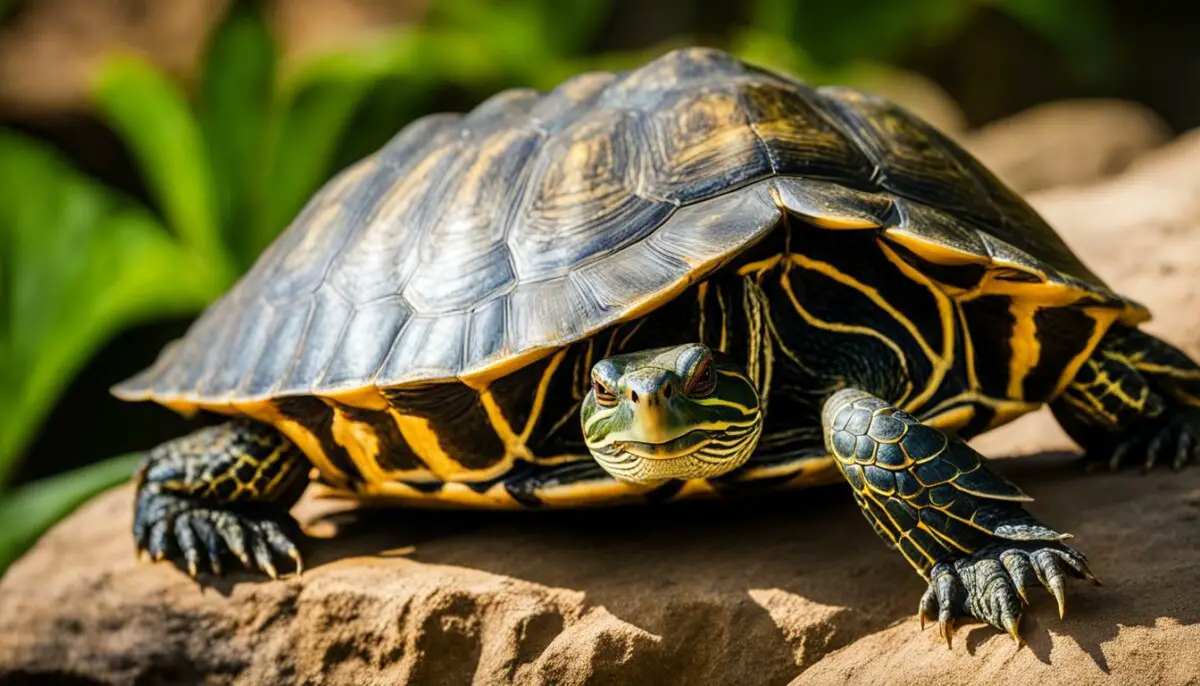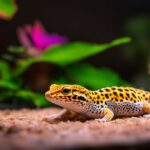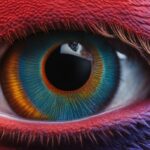Last Updated on 5 months by Francis
Red-eared sliders are popular pet turtles that require specific care to thrive. One important aspect of their care is providing adequate lighting in their enclosure. Infrared lights are commonly used as a heat source for these turtles, but there is some concern about their potential negative effects. Let’s delve into the impact of infrared lights on red-eared sliders and find out if they are bad for these beloved reptiles.
Contents
Key Takeaways:
- Infrared lights primarily emit heat, but do not provide the essential UVB wavelengths required by red-eared sliders.
- UVB light is crucial for vitamin D synthesis, calcium metabolism, and a strong immune system in red-eared sliders.
- Red-eared sliders require a balance of UVB and visible light sources to meet their lighting needs adequately.
- Natural daylight, whenever possible, should be incorporated to enhance the well-being of red-eared sliders.
- Proper lighting conditions are essential for the overall behavior and physiology of red-eared sliders.
The Importance of UVB for Red-Eared Sliders
When it comes to the health and well-being of red-eared sliders, access to UVB light is crucial. UVB enables the synthesis of vitamin D, which is essential for maintaining proper calcium levels and preventing metabolic bone disease. Additionally, UVB light plays a key role in strengthening the immune system of red-eared sliders, making them more resistant to diseases.
Unlike infrared lights, which primarily provide heat, UVB lights emit the necessary wavelengths that red-eared sliders require for optimal health. Relying solely on infrared lights can lead to deficiencies in vitamin D, potentially resulting in metabolic bone disease and other health problems.
To ensure proper UVB exposure, it is important to use high-quality UVB lamps that emit the appropriate wavelengths. The basking area should receive the highest UVB intensity, while other areas of the enclosure can have lower levels. The distance between the UVB lamp and the basking surface also plays a crucial role in determining the effectiveness of UVB exposure.
Table: UVB Lighting Requirements for Red-Eared Sliders
| UVB Light Requirements | Recommendation |
|---|---|
| Lamp Type | Linear fluorescent UVB bulbs |
| UVB Coverage | Cover 50-75% of the enclosure’s length |
| Distance | Optimal distance between the lamp and basking surface |
By providing red-eared sliders with the proper UVB lighting, their calcium metabolism and immune system can thrive, contributing to their overall health and longevity.
UVB Lighting Requirements for Red-Eared Sliders

When it comes to providing the right lighting for red-eared sliders, UVB exposure is essential for their health and well-being. UVB light enables the synthesis of vitamin D, which is crucial for maintaining proper calcium levels and preventing metabolic bone disease. However, concerns have been raised regarding the use of infrared lights for red-eared sliders and the risks associated with relying solely on this type of lighting.
To ensure adequate UVB exposure, it is important to use high-quality UVB lamps that emit the appropriate wavelengths. The basking area should receive the highest UVB intensity, as this is where the turtles spend most of their time. Other areas of the enclosure can have lower levels of UVB light. It is recommended to use linear fluorescent UVB bulbs that cover 50-75% of the enclosure’s length.
Placement of the UVB lamp is also critical. It should be positioned at the appropriate distance from the basking surface to ensure effective UVB exposure. Placing the lamp too close to the turtle can result in uneven coverage and potential harm, while placing it too far can lead to insufficient UVB exposure. By finding the right balance of UVB intensity and distance, red-eared sliders can receive the necessary UVB wavelengths for their overall health.
| UVB Lighting Requirements for Red-Eared Sliders: | |
|---|---|
| Use high-quality UVB lamps that emit the appropriate wavelengths. | – |
| The basking area should receive the highest UVB intensity. | – |
| Other areas can have lower levels of UVB light. | – |
| Use linear fluorescent UVB bulbs that cover 50-75% of the enclosure’s length. | – |
| Position the UVB lamp at the appropriate distance from the basking surface to ensure effective UVB exposure. | – |
Additional Lighting Considerations for Red-Eared Sliders
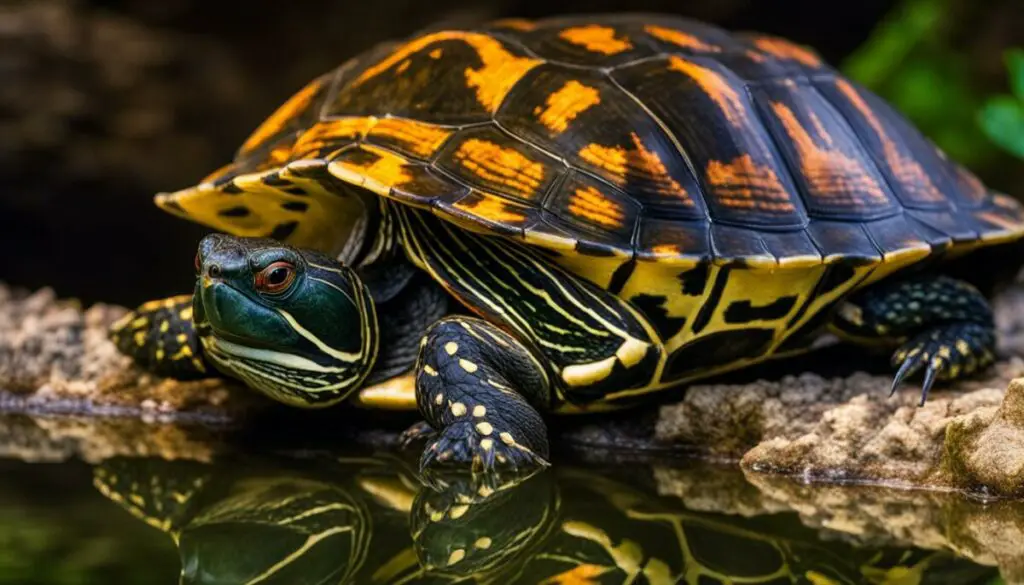
While UVB lighting is essential for red-eared sliders, it’s important to consider additional lighting options to create a more natural and beneficial environment for these turtles. In addition to UVB lamps, incorporating full-spectrum fluorescent or LED lamps with a color temperature of around 6400K can greatly enhance the lighting in the enclosure. These extra lights simulate natural daylight and provide a range of visible light that red-eared sliders need for optimal health.
Not only do these additional lights improve the mental well-being of red-eared sliders, but they also benefit any live plants present in their habitat. The full-spectrum lighting supports plant growth and photosynthesis, creating a more vibrant and natural-looking enclosure. However, it’s crucial to avoid using colored lights with red-eared sliders, as their sensitive eyes may be negatively affected by these lights.
In summary, while UVB lighting should be the primary focus for red-eared sliders, incorporating additional full-spectrum lighting can greatly enhance their overall well-being and create a more visually appealing habitat. Choosing the right combination of UVB and visible light sources is key to providing a balanced lighting environment for these turtles.
Benefits of Additional Lighting for Red-Eared Sliders
- Improves the mental well-being of red-eared sliders
- Supports plant growth and photosynthesis
- Creates a more vibrant and natural-looking enclosure
| Type of Lighting | Benefits |
|---|---|
| UVB Lighting | Essential for vitamin D synthesis and calcium metabolism |
| Full-Spectrum Lighting | Improves visible light levels and overall habitat aesthetics |
Duration of Lighting for Red-Eared Sliders

Providing the right duration of lighting is essential for the health and well-being of red-eared sliders. These turtles require a consistent day-night cycle to regulate their behavior and maintain their natural rhythms. Lights should be kept on for 11-13 hours a day to provide them with a suitable photoperiod. This means that the lights should be turned on in the morning and turned off in the evening to mimic the natural light patterns.
It is also important to adjust the length of the day period during different seasons. In the winter, when the days are shorter, the lights can be on for a shorter duration. In contrast, during the summer months, when the days are longer, the lights can be kept on for a longer period. This variation in lighting duration helps to replicate the natural seasonal changes that red-eared sliders would experience in their natural habitat.
To ensure a consistent lighting schedule, it is recommended to use light timers. These devices can automatically turn the lights on and off at specific times, allowing for a consistent day-night cycle even when you are not at home. Light timers are a convenient and effective way to provide the right duration of lighting for your red-eared sliders.
| Season | Duration of Lighting |
|---|---|
| Winter | 8-10 hours |
| Spring/Fall | 11-12 hours |
| Summer | 13-14 hours |
Table: Recommended duration of lighting for red-eared sliders during different seasons.
The Limitations of Infrared Lights

Infrared lights, while commonly used as a heat source for red-eared sliders, have certain limitations that can impact the overall health of these turtles. Unlike UVB lights, which are essential for their well-being, infrared lights do not provide the necessary wavelengths that support important physiological processes. This can lead to deficiencies in vitamin D synthesis, weakened immune systems, and an increased risk of health problems.
To understand the potential harm of infrared lights on red-eared sliders, it’s important to recognize that these turtles rely on UVB light for calcium metabolism and bone health. Without sufficient exposure to UVB wavelengths, red-eared sliders may develop metabolic bone disease, which can lead to skeletal deformities, weakened shells, and even death. Infrared lights alone cannot fulfill this essential requirement for their overall health and well-being.
While infrared lights can provide heat, they should not be the sole source of lighting for red-eared sliders. It is crucial to incorporate UVB lights that emit the appropriate wavelengths to ensure the turtles’ needs are met adequately. A balanced lighting environment, with both UVB and visible light sources, is essential to support the natural behaviors and physiological processes of red-eared sliders.
The Impact of Infrared Light on Red-Eared Sliders
Infrared light, despite its heat-providing properties, does not offer the essential UVB wavelengths required for red-eared sliders. This can have detrimental effects on their overall health. Without access to sufficient UVB light, red-eared sliders may experience vitamin D deficiencies, leading to weakened immune systems and an increased susceptibility to diseases. Infrared lights alone cannot meet the lighting needs of these turtles, and therefore, it is crucial to provide a balanced lighting environment that includes UVB lights to ensure their well-being.
Understanding the Natural Lighting Needs of Red-Eared Sliders
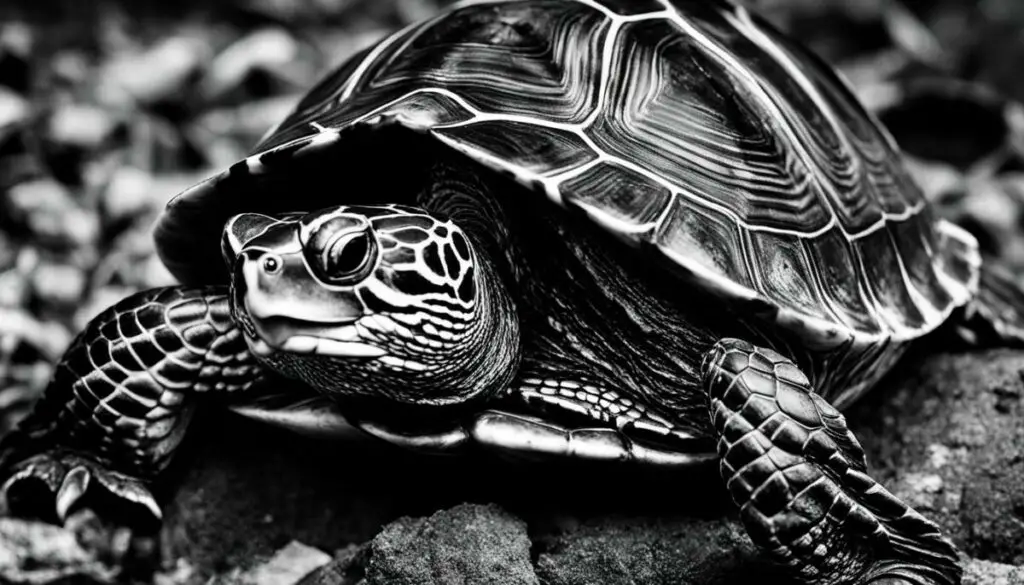
Red-eared sliders, like many other reptiles, have evolved to rely on natural sunlight for their overall well-being. The intensity and quality of natural light play a crucial role in their behavior and physiology. Artificial lighting, although necessary in captivity, can never fully replicate the complexity and benefits of natural sunlight. It is important to provide red-eared sliders with access to natural daylight whenever possible, either through outdoor enclosures or by using special UV-transmitting skylights and windows in indoor setups.
By allowing red-eared sliders to bask in natural sunlight, they are exposed to a full spectrum of light that closely mimics their natural habitat. This natural light helps regulate their daily and seasonal rhythms, influences their activity levels, and even impacts their reproductive cycles. Red-eared sliders rely on information gathered from their eyes and specialized brain areas to monitor daylight and adjust their behavior accordingly. Therefore, providing access to natural lighting conditions is essential for the overall well-being and natural functioning of red-eared sliders.
While artificial lighting systems can partially replicate natural daylight, they are unable to fully match its complexity. The use of infrared lights alone as the primary lighting source for red-eared sliders should be avoided. Although infrared lights provide heat, they do not offer the necessary UVB wavelengths that are essential for the turtles’ calcium metabolism and immune system. It is important to provide a balanced lighting environment for red-eared sliders by incorporating both UVB and visible light sources, such as full-spectrum fluorescent or LED lamps. Natural daylight should also be incorporated whenever possible to meet their natural lighting needs.
The Role of Infrared and Visible Light in Reptiles
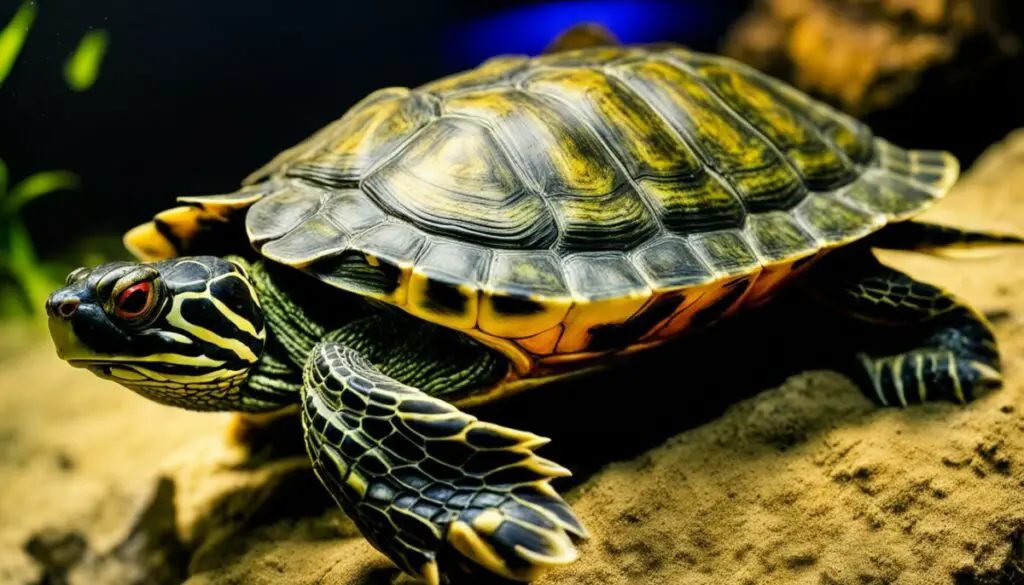
Infrared light is a type of light that provides warmth and is absorbed by reptiles, including red-eared sliders, through their skin. It is invisible to humans but can be perceived by some snakes through specialized organs. Visible light, including UVA, is important for reptiles’ color vision and perception of their environment. Red-eared sliders, in particular, have excellent color vision and can see a broader range of colors compared to humans. This extra color perception helps them recognize others of their species and identify food items.
“Infrared light, although invisible to us, plays a crucial role in providing warmth to reptiles like red-eared sliders. It is an essential component of their natural environment.”
While infrared light is vital for reptiles’ thermoregulation, it is important to note that it does not provide the necessary UVB wavelengths required for the overall health of red-eared sliders. UVB light, which is absent in infrared light, is crucial for the synthesis of vitamin D, calcium metabolism, and the proper functioning of the immune system. Therefore, relying solely on infrared lights can lead to deficiencies and health problems in red-eared sliders.
Understanding the importance of both infrared and visible light is key to providing the appropriate lighting conditions for red-eared sliders. Infrared light allows them to experience the necessary warmth, while visible light, including UVA, enhances their color vision and perception. By incorporating both types of light in their habitat, we can ensure a more natural and balanced environment for these fascinating reptiles.
| Type of Light | Importance |
|---|---|
| Infrared Light | Provides warmth |
| Visible Light (UVA) | Aids color vision and perception |
| UVB Light | Essential for vitamin D synthesis, calcium metabolism, and immune system functioning |
The Impact of Light on Reptile Behavior and Physiology
Light plays a crucial role in the behavior and physiology of reptiles, including red-eared sliders. It helps set daily and seasonal rhythms, regulates activity levels, and influences reproductive cycles and thermoregulation. Reptiles, like red-eared sliders, rely on information from their eyes and specialized brain areas to monitor daylight and adjust their behavior accordingly.
Research has shown that inadequate lighting conditions can have negative effects on reptiles. Concerns have been raised regarding the use of infrared lights for red-eared sliders, as they do not provide the necessary UVB wavelengths essential for their overall health. Relying solely on infrared lights can lead to deficiencies in vitamin D, resulting in metabolic bone disease and other health issues.
Proper lighting, including UVB and visible light sources, is crucial for the well-being and natural functioning of red-eared sliders. UVB lamps should be used to ensure sufficient exposure to the necessary wavelengths, while additional lighting sources can enhance visible light levels. It is recommended to avoid using infrared lights as the primary source of lighting for red-eared sliders, as they do not provide UVB wavelengths and can lead to deficiencies and health problems.
The Role of UVB Lighting in Red-Eared Slider Care
| UVB Lighting Benefits | UVB Lighting Requirements |
|---|---|
| Ensures proper calcium metabolism and prevents metabolic bone disease | Use high-quality UVB lamps that emit appropriate wavelengths |
| Strengthens the immune system and promotes overall health | Place the UVB lamp at the correct distance from the basking surface |
| Supports vitamin D synthesis | Use linear fluorescent UVB bulbs covering 50-75% of the enclosure’s length |
By providing the right balance of UVB and visible light sources, along with access to natural daylight whenever possible, red-eared sliders can thrive in their captive environments.
Finding the Right Balance in Lighting for Red-Eared Sliders
When it comes to providing optimal lighting for red-eared sliders, finding the right balance is crucial. While infrared lights can provide heat, they do not offer the necessary UVB wavelengths that are essential for the turtles’ overall health. Therefore, relying solely on infrared lights can lead to deficiencies in vitamin D and other health problems. To meet the lighting needs of red-eared sliders adequately, it is important to use UVB lamps to ensure sufficient exposure to the necessary wavelengths.
In addition to UVB lighting, it is also important to consider the role of visible light in the enclosure. Full-spectrum fluorescent or LED lamps with a color temperature of around 6400K can be used to enhance visible light levels. These extra lights not only improve the turtle’s mental health but also benefit any live plants that may be present in the habitat.
To summarize, red-eared sliders should avoid relying solely on infrared lights as their primary source of lighting. Instead, a combination of UVB lamps and additional visible light sources should be used to provide a balanced lighting environment. Natural daylight should also be incorporated whenever possible to meet the turtles’ natural lighting needs.
| Pros | Cons |
|---|---|
| UVB lamps provide the necessary wavelengths for vitamin D synthesis and overall health | Relying solely on infrared lights can lead to deficiencies and health problems |
| Additional visible light enhances the turtle’s mental health and benefits live plants | Infrared lights do not offer the necessary UVB wavelengths |
| Natural daylight provides the full spectrum of light and benefits of natural sunlight | Artificial lighting systems cannot fully replicate natural daylight |
The Importance of Natural Lighting in Reptile Care
Natural lighting plays a crucial role in the care of red-eared sliders and other reptiles. While artificial lighting systems can partially replicate the benefits of natural daylight, they are unable to fully match its complexity and advantages. Concerns regarding infrared lights for red-eared sliders arise because these lights do not provide the necessary UVB wavelengths that are essential for the turtles’ overall health. Therefore, it is highly recommended to provide red-eared sliders with access to natural daylight whenever possible.
One way to incorporate natural lighting is through outdoor enclosures. Allowing red-eared sliders to spend time outside exposes them to the full spectrum of natural light, which helps regulate their daily and seasonal rhythms. The intensity and color changes that occur throughout the day provide essential visual stimuli and promote the turtles’ natural behavior and physiological processes. It is important to ensure that outdoor enclosures provide both sunny and shaded areas to allow the turtles to regulate their exposure to natural light.
In indoor setups, special UV-transmitting skylights and windows can be used to provide access to natural daylight. These devices allow the reptiles to benefit from the full spectrum of light, including UVB, UVA, and visible light. By mimicking natural sunlight, these lighting systems help regulate the turtles’ behavior and support their overall well-being. It is recommended to consult with reptile lighting experts to determine the best options for creating a natural lighting environment indoors.
| Benefits of Natural Lighting for Red-Eared Sliders | Risks of Using Infrared Lights |
|---|---|
|
|
In conclusion, risks of using infrared lights for red-eared sliders are related to the lack of UVB wavelengths necessary for their overall health. While infrared lights may provide heat, they cannot replace the benefits of natural daylight. It is crucial to prioritize natural lighting whenever possible, whether through outdoor enclosures or specialized lighting setups in indoor environments. By providing red-eared sliders with access to natural lighting, we can ensure their well-being and support their natural behavior and physiological processes.
Conclusion
After considering the impacts of infrared lights on red-eared sliders, it is clear that relying solely on these lights can be detrimental to the turtles’ overall health. While infrared lights do provide heat, they do not emit the necessary UVB wavelengths that are vital for their calcium metabolism and immune system.
To ensure the well-being of red-eared sliders, it is important to incorporate UVB and visible light sources in their lighting environment. UVB lamps should be used to provide the required wavelengths, while additional full-spectrum fluorescent or LED lamps can enhance visible light levels in the enclosure.
While artificial lighting systems can partially replicate natural daylight, they cannot fully match its complexity and benefits. Therefore, whenever possible, it is recommended to provide red-eared sliders with access to natural daylight through outdoor enclosures or specialized lighting setups that mimic natural sunlight.
In conclusion, while infrared lights may provide some heat, they are not suitable as the sole source of lighting for red-eared sliders. A balanced lighting environment that includes UVB and visible light sources, along with access to natural daylight, is essential for the overall health and well-being of these turtles.
FAQ
Are infrared lights bad for red-eared sliders?
Infrared lights alone are not sufficient for red-eared sliders’ overall health and well-being. While they can provide heat, they do not offer the necessary UVB wavelengths that are essential for the turtles’ calcium metabolism and immune system. It is important to use both UVB and visible light sources, such as full-spectrum fluorescent or LED lamps, to provide a balanced lighting environment for red-eared sliders. Natural daylight should also be incorporated whenever possible to meet their natural lighting needs.
What are the negative effects of infrared lights on turtles?
Relying solely on infrared lights can lead to deficiencies in vitamin D, resulting in metabolic bone disease and other health issues in red-eared sliders. Infrared lights do not provide the necessary UVB wavelengths that are crucial for maintaining proper calcium levels, preventing metabolic bone disease, and strengthening the immune system of red-eared sliders.
What are the concerns regarding infrared lights for red-eared sliders?
The primary concern is that infrared lights do not emit the necessary UVB wavelengths that red-eared sliders need for their overall health. Relying solely on infrared lights for heating can lead to deficiencies in vitamin D and health problems, including metabolic bone disease. It is important to provide a balanced lighting environment with both UVB and visible light sources.
What are the risks of using infrared lights for red-eared sliders?
Using infrared lights as the sole source of lighting for red-eared sliders can lead to deficiencies in vitamin D and health problems, including metabolic bone disease. Red-eared sliders require access to UVB light for proper calcium metabolism, immune system function, and overall well-being. Infrared lights do not provide the necessary UVB wavelengths and should be supplemented with UVB and visible light sources.
What are the potential dangers of infrared lights on red-eared sliders?
The primary danger is that relying solely on infrared lights can lead to deficiencies in vitamin D and health problems, including metabolic bone disease. Infrared lights do not offer the necessary UVB wavelengths that red-eared sliders need for their overall health. It is important to provide a balanced lighting environment with both UVB and visible light sources to meet their lighting needs adequately.
Why should red-eared sliders avoid infrared lights?
Red-eared sliders should avoid relying solely on infrared lights because they do not provide the necessary UVB wavelengths that are essential for their overall health. UVB light enables the synthesis of vitamin D, which is crucial for maintaining proper calcium levels, preventing metabolic bone disease, and strengthening the immune system of red-eared sliders. It is important to supplement infrared lights with UVB and visible light sources to meet their lighting needs adequately.
What is the impact of light on reptile behavior and physiology?
Light plays a crucial role in reptiles’ behavior and physiology. It helps in setting daily and seasonal rhythms, regulates activity levels, and influences reproductive cycles and thermoregulation. Reptiles, including red-eared sliders, use information from their eyes and specialized brain areas to monitor daylight and adjust their behavior accordingly. Therefore, providing appropriate lighting conditions is essential for the overall well-being and natural functioning of red-eared sliders.
Why is there a concern about infrared lights for red-eared sliders?
The concern about infrared lights for red-eared sliders is due to the fact that they do not emit the necessary UVB wavelengths that are essential for the turtles’ calcium metabolism and immune system. Relying solely on infrared lights for heating can lead to deficiencies in vitamin D, resulting in metabolic bone disease and other health issues in red-eared sliders. It is important to provide a balanced lighting environment with both UVB and visible light sources.
What are the potential dangers of infrared lights on red-eared sliders?
The potential dangers of infrared lights on red-eared sliders include deficiencies in vitamin D, which can lead to health problems like metabolic bone disease. Infrared lights do not provide the necessary UVB wavelengths that are crucial for maintaining proper calcium levels and strengthening the immune system of red-eared sliders. It is important to supplement infrared lights with UVB and visible light sources to meet their lighting needs adequately.
What is the importance of natural lighting in reptile care?
Natural lighting, including sunlight, is crucial for reptile care. It provides the full spectrum of light and the intensity and color changes that occur throughout the day. While artificial lighting systems can partially replicate natural daylight, they are unable to fully match its complexity and benefits. Therefore, whenever possible, it is recommended to provide red-eared sliders with access to natural daylight through outdoor enclosures or specialized lighting setups that mimic natural sunlight.

